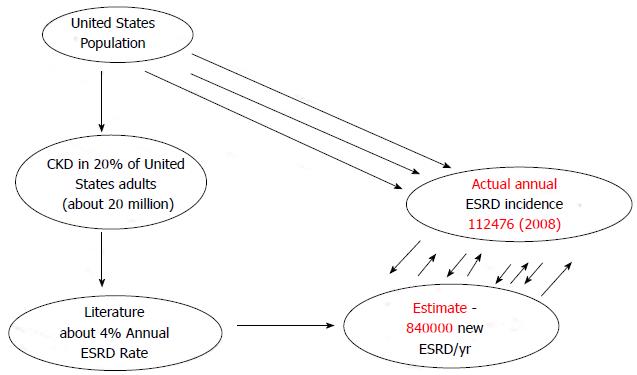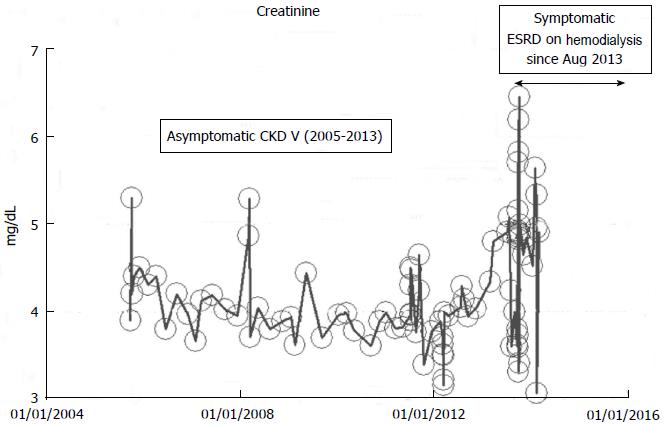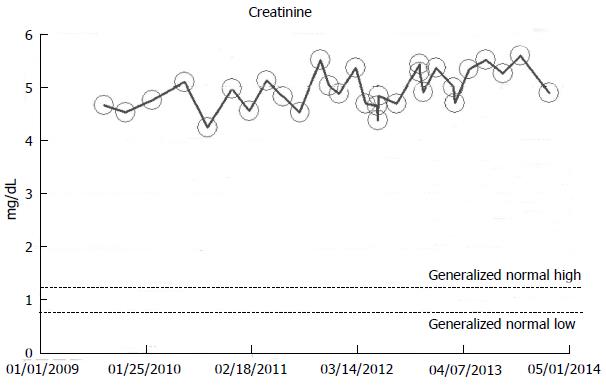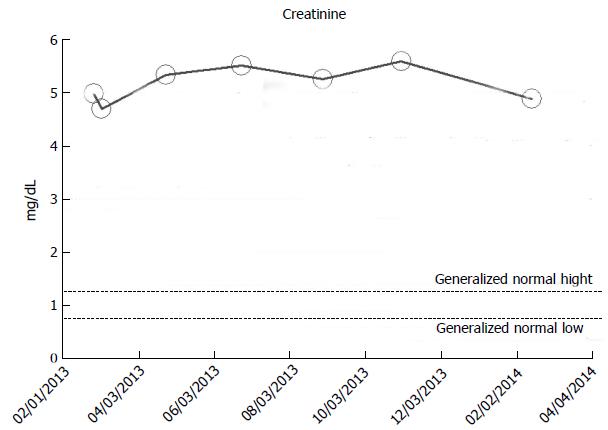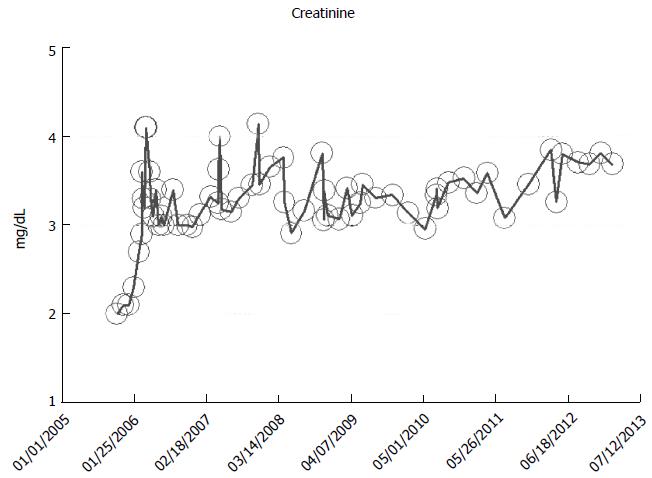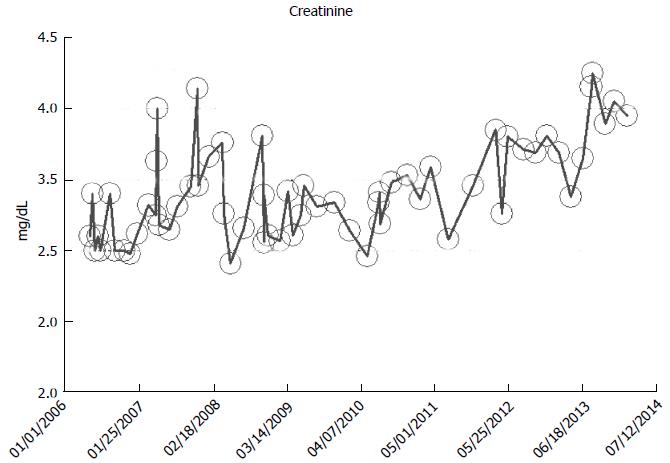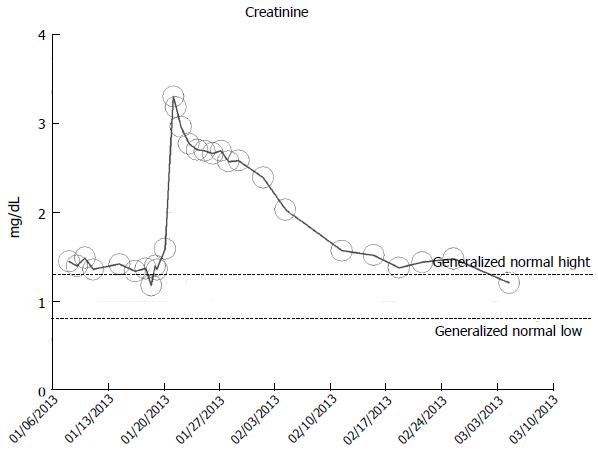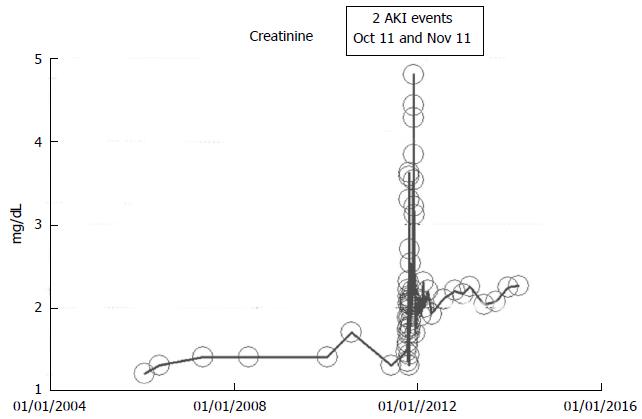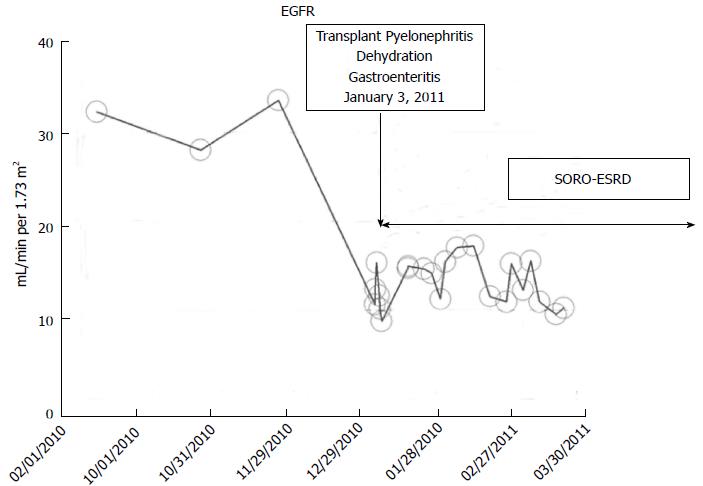Copyright
©2014 Baishideng Publishing Group Inc.
Figure 1 Gross overestimation of annual incident end stage renal disease patients for 2008 from projected estimates based on annualized end stage renal disease rates from three cited concurrent United States chronic kidney disease cohort studies.
CKD: Chronic kidney disease; ESRD: End stage renal disease.
Figure 2 A now 82-year-old white male on maintenance hemodialysis August 2013-March 2014, after 8 years of asymptomatic chronic kidney disease V, as monitored and tracked through a simulation of The chronic kidney disease Express© IT Software Program.
CKD: Chronic kidney disease; ESRD: End stage renal disease.
Figure 3 A now 78-year-old white male on with asymptomatic stable chronic kidney disease V for 8 years, 2006-2014, serum creatinine of 4.
5-5.5 mg/dL (eGFR 8-11 mL/min per 1.73 m2 Body Surface Area), as monitored and tracked through a simulation of The chronic kidney disease Express© IT Software Program. eGFR: Glomerular filtration rates.
Figure 4 A now 78-year-old white male on with asymptomatic stable chronic kidney disease V for 8 year, 2006-2014, serum creatinine of 5.
0-5.5 mg/dL (eGFR 8-11 mL/min per 1.73 m2 Body Surface Area), in the last one year, February 2013-March 2013, as monitored and tracked through a simulation of The chronic kidney disease Express© IT Software Program. eGFR: Glomerular filtration rates.
Figure 5 A now 78-year-old white male with treated Wegener’s Granulomatoisis in remission since 2006, with new stable chronic kidney disease IV 2008-2014, following initial acute kidney injury on chronic kidney disease in 2005, as monitored and tracked through a simulation of The chronic kidney disease Express© IT Software Program.
Figure 6 The same patient as in Figure 5 has remained otherwise an asymptomatic chronic kidney disease IV patient between 2006 and early 2014, serum creatinine of 3.
5-4.0 mg/dL (eGFR 16-22 mL/min per 1.73 m2 Body Surface Area), as monitored and tracked through a simulation of The chronic kidney disease Express© IT Software Program. eGFR: Glomerular filtration rates.
Figure 7 Serum creatinine trajectory in a now 92-year-old Caucasian female patient who despite multiple repeated AKI episodes between 2006 and 2012, has otherwise maintained a baseline serum creatinine of 1.
7-2.0 mg/dL through March 2014, as monitored and tracked through a simulation of The chronic kidney disease Express IT Software Program. AKI: Acute kidney injury.
Figure 8 Serum creatinine trajectory in an 48-year-old obese hypertensive male patient who developed acute kidney injury from biopsy-proved acute interstitial nephritis complication methicillin-resistant Staphylococcus Aureus septicemia, with full renal recovery after one month, as monitored and tracked through a simulation of The chronic kidney disease Express© IT Software Program.
AKI: Acute kidney injury.
Figure 9 Serum creatinine trajectory in an 85-year-old obese hypertensive female patient who developed acute kidney injury following a complicated right hemicolectomy with small intestinal resection and ileo-colic anastomosis in October 2011, with partial but stable renal recovery (chronic kidney disease IV) after one month, as monitored and tracked through a simulation of The chronic kidney disease Express© IT Software Program.
Figure 10 Serum creatinine trajectory in a 82-year-old white male patient with features of the predictable linear chronic kidney disease to end stage renal disease progression from 2006 through 2010 when he started hemodialysis for symptomatic uremia, as monitored and tracked through a simulation of The chronic kidney disease Express© IT Software Program.
ESRD: End stage renal disease; HD: Hemodialysis.
Figure 11 Serum creatinine trajectory in a 52-year-old white male patient with features of the predictable linear chronic kidney disease to end stage renal disease progression from 2007 through 2010 when he started hemodialysis for symptomatic uremia, as monitored and tracked through a simulation of The chronic kidney disease Express© IT Software Program.
ESRD: End stage renal disease; HD: Hemodialysis.
Figure 12 Serum creatinine trajectory, 2010-2012, with post-operative acute kidney injury precipitating acute yet irreversible end stage renal disease in March 2012 while on concurrent ACE inhibition, following minimally invasive aortic valve replacement in a then 73-year-old thin white woman.
SORO-ESRD: Syndrome of rapid onset end-stage renal disease.
Figure 13 Estimated glomerular filtration rates trajectory in a renal transplant recipient following acute kidney injury and Syndrome of Rapid Onset End-Stage Renal Disease in January 2011, was on maintenance in-center hemodialysis for 12 mo and received a second living related kidney transplant from 32-year-old son in January 2012 at Mayo Clinic, Rochester.
SORO-ESRD: Syndrome of rapid onset end-stage renal disease. EGFR: Estimated glomerular filtration rates.
- Citation: Onuigbo MAC, Agbasi N. Chronic kidney disease prediction is an inexact science: The concept of “progressors” and “nonprogressors”. World J Nephrol 2014; 3(3): 31-49
- URL: https://www.wjgnet.com/2220-6124/full/v3/i3/31.htm
- DOI: https://dx.doi.org/10.5527/wjn.v3.i3.31









